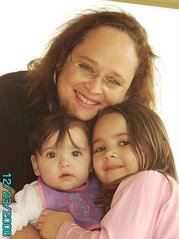We created these lesson plans for Dr. Wright's summer 2006 class about various approaches in teaching ESL. I thought I would share it here. This was the fifth week's lesson in our adult ESL students' hypothetical classroom. The previous day's lesson was on sports and the following day was on food (Rita's day). We wanted to bring as much of the students' cultures into the classroom as possible, scaffold the lessons, and work on eliciting structured output (Lee & Van Patten, 2005). Feel free to use this lesson plan, but please let me know how it works for you, and if you make any cool modifications. Here is the lesson plan and activities to go with it:
Instructor: Joleen Group Level: High Beginners Week #: 5
Objectives: Students will share information about their culture and learn about other cultures. Students will be able to use nouns to describe various family members. Students will review and practice comparative adjectives.
Warm Up: What did you talk about yesterday? Who do watch sports with? Who do you play sports with? Today we are going to talk about families. (HOMEWORK: Check to see who brought pictures from yesterday’s class.)
Introduction: I am from a big family. Count immediate family, cousins, aunts, uncles, grandparents. Teach "immediate" and "extended" families. Explain that a family is usually someone you live with, but the family members can vary. I presented and modeled the vocabulary by describing my extended family with an old picture I have of about 20 of us. It is funny, because it is very 70s!
Activity 1: Family tree: Think, Pair, Share. Pass out or have students create a family tree chart. Model the activity for the students by describing a family member in the (teacher’s family) picture. For example, I would point to my aunt and say, “She is MY aunt, but she is also a sister, a daughter, a wife, and a mother.” They will each choose two of their own family members and make a list of all the family roles each one fulfills (ex. My brother is also a son, etc.) Then they describe themselves and all of the family roles they fulfill. Bring extra pictures of famous families, like The Simpsons, or magazines with a lot of pictures (such as National Geographic or People), to class—in case students forget to bring their own. After sharing their lists with their partners, ELLs can then report findings to the whole group.
Activity 2: Introduce language for comparing/contrasting for language objective (bigger, smaller, younger, older, more/fewer children, etc.) Then, in small groups, students examine three family pictures from
1000 Families: Family Album of the Planet Earth by Uwe Ommer and compare/contrast these three families with the others and then with their own families. There is a list of questions provided here to guide the ELLs They then get up, find a partner from another group and share their discoveries...were they the same or different? Optional: If time, they will report findings back to their original groups.
Activity 2 Questions: Examine these family pictures from around the world and answer these questions with your group.
1. What do you notice first about these families?
2. Do you think this is a traditional family in this culture? Why or
why not?
3. What is different about each family?
4. What is the same or similar about each family?
5. Are these families similar to the families in your country? Which one is the most similar? What do you notice first about these families?
Extension/synthesis: Individual work, then groups: They take a T/F survey to think about and prepare for writing about traditional family structure in their cultures or their own families (attached). 2 columns: “In my family, country.” They complete it, then use this as a checklist as a springboard to write a paragraph about traditional families from their own countries. They then share with small groups orally and report to whole group. Activity guide below:
Consider if there is a traditional family structure in your country/culture. Answer True or False for your family and the traditional family in your country.
My family/My country
1. Mothers work outside the home.
2. Fathers are the main money makers.
3. Children live at home until they get married.
4. Grandparents often live with their children and grandchildren.
5. Daughters usually take care of their parents when the parents get older.
6. Children do chores and get money for helping the parents.
7. Husbands and wives share household responsibilities like cooking and cleaning.
8. Parents always pay for their children to go to college/university.
Write: Read your answers again and write a paragraph or two about traditional families in your country/culture. If there is no traditional family, write about that.
(Bonus activity--in case we have extra time: have them pair up and describe their favorite, most recent, or ideal, family vacation.)
Homework: To prepare them to talk about family meals the next day, here are the T/F questions they will think about:
True or False: In my country, families usually...--eat together almost every night.
--eat with a fork and knife.
--sit on the floor to eat.
--have food prepared by mom.
--eat their biggest meal at night.
Teaching approaches and activities:
Communicative Language Teaching, Richards and Rodgers, Chapter 14
Activity 1 inspired by Lee & Van Patten, “Writing and Composing in a Second Language” Composing-Oriented Activities D-G, pp. 222-224
Extension/ Synthesis Activity inspired by Lee & Van Patten,”Comprehending Written Language,” Activity H, p. 206
References:
Jack C. Richards & Theodore S. Rodgers (2001). Approaches and Methods in Language Teaching (2nd ed.). Cambridge, UK: Cambridge University Press. (R&R)
James F. Lee & Bill Van Patten (1995). Making Communicative Language Teaching Happen (1st ed.). New York: McGraw-Hill. (L&P)
Pictures from: Ommer, U. (2000). 1000 Families: Family Album of the Planet Earth , Germany: Taschen, images retrieved July 10, 2006, from: www.clubcultura.com/clubfoto/milfamilias/uwe.htm
Wednesday, April 11, 2007
Subscribe to:
Post Comments (Atom)


No comments:
Post a Comment